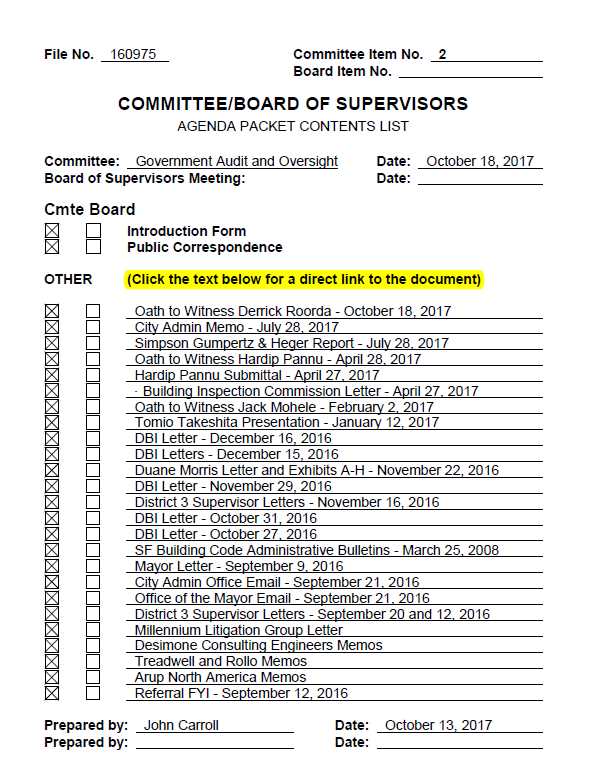- Thread starter
- #161
Navigation
Install the app
How to install the app on iOS
Follow along with the video below to see how to install our site as a web app on your home screen.
Note: This feature may not be available in some browsers.
More options
Style variation
-
Congratulations cowski on being selected by the Eng-Tips community for having the most helpful posts in the forums last week. Way to Go!
You are using an out of date browser. It may not display this or other websites correctly.
You should upgrade or use an alternative browser.
You should upgrade or use an alternative browser.
SF tower settlement 25
- Thread starter hokie66
- Start date
- Status
- Not open for further replies.
Yeah, saw the 60 Minutes story last night. One thing that jumped out at me was the claim that the settlement was due to the piles not going to bedrock. But if they had adequate capacity without going that deep.......why should they?
Scariest moment to me (in the 60 Minutes story): the attorney get together. So many of them, it takes (IIRC) 30 minutes to get down everyone's name.
Scariest moment to me (in the 60 Minutes story): the attorney get together. So many of them, it takes (IIRC) 30 minutes to get down everyone's name.
- Thread starter
- #164
As in all other structural elements, the capacity of piles is not the full story. Serviceability, as in deflection and settlement, can't be ignored.
True. But I doubt the SE ignored that. In fact, they had a settlement estimate that the building was supposed to see over a 100 year period. (4" if memory serves.) To be sure they considered that level of P-Delta. (In the wind or seismic cases at least.)
Nobody is really owning up to it (as per the story on 60 Minutes).....but my gut instinct is the piles are in a strata that isn't what they anticipated.
JedClampett
Structural
I thought the "60 Minutes" was pretty good, although I don't know what the point of the Danish guy on there was. He could tell from satellite images that the towers were settling? Or you could look in the buildings.
Way back in this thread, I linked to the Ocean Tower in South Padre Island, TX. The piles carried the load to compressible materials and they compressed. This is sounding more and more like that.
Way back in this thread, I linked to the Ocean Tower in South Padre Island, TX. The piles carried the load to compressible materials and they compressed. This is sounding more and more like that.
- Thread starter
- #167
There may be a fix in the works for San Francisco's very own "leaning tower."
Millennium Tower has sunk 17 inches and tilted 14 inches since its completion in 2008. Satellite images suggest the residential high-rise — home to more than 200 multimillion-dollar condos — will continue to sink two inches per year.
link:
Millennium Tower has sunk 17 inches and tilted 14 inches since its completion in 2008. Satellite images suggest the residential high-rise — home to more than 200 multimillion-dollar condos — will continue to sink two inches per year.
link:
So now the curtain wall is presumed to be suffering from differential settlement. I watched an earlier video of the San Francisco Government Audit and Oversight Committee 10/28/2016 where Supervisor Peskin discussed with San Francisco Dept of Building Inspection (SFDBI), the differences in the two versions of the Simpson Gumpertz & Heger "301 Mission Seismic Evaluation" It seems the 2014 version which has not been made public, implied the mat foundation had already cracked from dishing. You can't see the cracks because they haven't migrated from the bottom of the mat to the surface YET. Simpson Gumpertz & Heger removed this line of inquiry from the more recent 2016 seismic report. I don't have the exact words but they divorce themselves from any comment regarding the health of the concrete foundation. Supervisor Peskin described the newer report as "Lawyered Up". The Director of SFDBI had written to Ron Hamberger at Simpson Gumpertz & Heger and asked for more detailed information about the dishing of the 10 foot mat. He was concerned that the greatest degree of dishing was under the northwest super-column at the edge of the foundation. The super-columns tie in to the outriggers off the shear walls in the core. The dishing migrates from the super-column back towards the north 3rd of the core. This was all in October of last year. If I had to guess, the curtain wall is starting to fail at about the northwest super-column. The curtain wall separation is compromising the Fire compartmentalization between units.
"
San Francisco city building inspectors have issued a citation against a tilting 58-story residential tower for an apparent fire safety risk.
KNTV of San Jose reports the Department of Building Inspection issued the violation notice last month for the Millennium Tower after consultants found the tilting building was exacerbating gaps between the facade its concrete and steel core.
Experts say smoke and flames can shoot through such gaps, making it easier for a fire to jump to a higher floor.
The fire safety hazard warning was part of a December 2016 report commissioned by the Millennium Homeowners Association after a condo owner complained of a mysterious odour.
City officials issued the notice a week after the TV station reported on the warning."
Link:
San Francisco city building inspectors have issued a citation against a tilting 58-story residential tower for an apparent fire safety risk.
KNTV of San Jose reports the Department of Building Inspection issued the violation notice last month for the Millennium Tower after consultants found the tilting building was exacerbating gaps between the facade its concrete and steel core.
Experts say smoke and flames can shoot through such gaps, making it easier for a fire to jump to a higher floor.
The fire safety hazard warning was part of a December 2016 report commissioned by the Millennium Homeowners Association after a condo owner complained of a mysterious odour.
City officials issued the notice a week after the TV station reported on the warning."
Link:
Test Drilling Launched at the Sinking Millennium Tower Link
There has yet to be any disclosure by Millennium Partners, DeSimone, Treadwell & Rollo or Webcor Builders as to why the building is sinking & tilting. I have been through the information the SF Government Audit and Oversight Committee has on their site & I guarantee you that they are not being as forthcoming, as they could be. Even the SG&H 2017 "Supplement" commissioned by the SF Mayor's Office - 301 Mission Seismic Safety Committee is flawed. For starters the bore hole used to characterize all the piles isn't even under the tower. It is 25 feet to the east of the tower under the podium. Why not use any of the 5 bore holes that are under the tower? Other than that they pass through more clay and less sand at inappropriate elevations.
Spending millions of dollars on an exploratory remedial program when you have yet to fully examine the cause is imprudent. To what extent the HOA is being led down this road by Millennium Partners or other parties is a mystery. If it is a judge who is urging the homeowners to work towards a remedy at the expense of knowing all the facts, then that is unfortunate. I can guarantee you Millennium Partners, DeSimone or Treadwell & Rollo or Webcor Builders all know why the building is tilting & rotating.
SFDBI is no innocent party either. We have all seen the photos of the cracks & crack gauges in the basement. So on Tuesday February 9 2009 SFDBI's Deputy Director Raymond Lui writes to DeSimone regarding excessive Settlement of the Tower. On February 11 & 12 (Thurs & Fri) SFDBI Field Inspector for Major Projects, District 1: Yuang-Tam Chiu makes site verification inspections at 301 Mission. Yet SFDBI Tom Hui & Ron Tom have stated in testimony before the SF Government Audit and Oversight Committee that everything looked fine and no signs of settling were observed. But all the cracks were there! From 24 to 29 April 2009 ARUP installs 103 crack monitoring gauges in just the basement of Millennium Tower, only 79 Days since SFDBI's Ray Lui wrote Settlement Inquiry Letter. On 11 August & 19 August 2009 SFDBI Field Inspector Yuang-Tam Chiu does a Pre-Final & Final Inspection at 301 Mission. There are Crack Gauges! Crack Gauges Everywhere!. 156 days since the TOC was issued. 103 crack gauges are visible along the walls of the Tower Basement Level B-1. Mostly clustered on the North & South ends of the building. Not one request to see any surveyor data or reports. Final Inspection Approved.
If the Mat foundation is already cracked as Ron Hamburger at SG&H speculated in 2014, then where do they begin installing piles, since coring large diameter holes in the mat "could" make matters worse? The HOA should at least do some Pulse-Echo Testing of the foundation before they get too far into the piling scheme. Having to position & re-position equipment in a basement in order to satisfy a charted installation designed to prevent additional damage to the mat could greatly increase the time & expense. Has Millennium even told them that corrosion control is going to be needed long-term? The ground water is brackish. It isn't particularly expensive but it is a consequence of cracking in the foundation.
There has yet to be any disclosure by Millennium Partners, DeSimone, Treadwell & Rollo or Webcor Builders as to why the building is sinking & tilting. I have been through the information the SF Government Audit and Oversight Committee has on their site & I guarantee you that they are not being as forthcoming, as they could be. Even the SG&H 2017 "Supplement" commissioned by the SF Mayor's Office - 301 Mission Seismic Safety Committee is flawed. For starters the bore hole used to characterize all the piles isn't even under the tower. It is 25 feet to the east of the tower under the podium. Why not use any of the 5 bore holes that are under the tower? Other than that they pass through more clay and less sand at inappropriate elevations.
Spending millions of dollars on an exploratory remedial program when you have yet to fully examine the cause is imprudent. To what extent the HOA is being led down this road by Millennium Partners or other parties is a mystery. If it is a judge who is urging the homeowners to work towards a remedy at the expense of knowing all the facts, then that is unfortunate. I can guarantee you Millennium Partners, DeSimone or Treadwell & Rollo or Webcor Builders all know why the building is tilting & rotating.
SFDBI is no innocent party either. We have all seen the photos of the cracks & crack gauges in the basement. So on Tuesday February 9 2009 SFDBI's Deputy Director Raymond Lui writes to DeSimone regarding excessive Settlement of the Tower. On February 11 & 12 (Thurs & Fri) SFDBI Field Inspector for Major Projects, District 1: Yuang-Tam Chiu makes site verification inspections at 301 Mission. Yet SFDBI Tom Hui & Ron Tom have stated in testimony before the SF Government Audit and Oversight Committee that everything looked fine and no signs of settling were observed. But all the cracks were there! From 24 to 29 April 2009 ARUP installs 103 crack monitoring gauges in just the basement of Millennium Tower, only 79 Days since SFDBI's Ray Lui wrote Settlement Inquiry Letter. On 11 August & 19 August 2009 SFDBI Field Inspector Yuang-Tam Chiu does a Pre-Final & Final Inspection at 301 Mission. There are Crack Gauges! Crack Gauges Everywhere!. 156 days since the TOC was issued. 103 crack gauges are visible along the walls of the Tower Basement Level B-1. Mostly clustered on the North & South ends of the building. Not one request to see any surveyor data or reports. Final Inspection Approved.
If the Mat foundation is already cracked as Ron Hamburger at SG&H speculated in 2014, then where do they begin installing piles, since coring large diameter holes in the mat "could" make matters worse? The HOA should at least do some Pulse-Echo Testing of the foundation before they get too far into the piling scheme. Having to position & re-position equipment in a basement in order to satisfy a charted installation designed to prevent additional damage to the mat could greatly increase the time & expense. Has Millennium even told them that corrosion control is going to be needed long-term? The ground water is brackish. It isn't particularly expensive but it is a consequence of cracking in the foundation.
-
5
- #174
Just to get started, the Millennium Tower is not built on top of fill that is at risk of liquefaction. The basement penetrates the fill.
It looks like The Millennium Tower HOA is moving forward with an objective to stabilized the Millennium Tower. LERA & Swinerton Builders are the team overseeing the work. Documents on file for 301 Mission at the SF Planning Dept. website show they will be coring possibly two penetrations through the 10 foot mat foundation at the north end of the tower, approx mid tower.
They will also be opening up the the wall of the parking structure at parking level 2, cutting two 3 ft by 3 ft openings, in order to determine if the tower has come to rest on the soldier piles of the CDSM shoring wall between the tower & the podium structure. In Treadwell & Rollo's 2005 Geotechnical Report, T&R had recommended that since the CDSM shoring wall was to be directly beneath the mat foundation, the shoring wall should be at least 12 inches below the mat, to avoid interference.
The tower may or may not be resting on the shoring wall. If it is, that will at least give engineers something to think about but if it is not, then they will have to consider the consequences and how much time they have before it does and matters become more critical. The soldier piles were about 1 foot higher than the CDSM shoring. In hindsight one would think the developer's team ought to have given thought to cutting the soldier piles down, since Treadwell & Rollo's second estimate for additional settlement of the tower was still a large number AND they knew or should have, well before the last level of the parking structure was poured, that shoring wall interference could be a factor. As soon as the last struts of the podium were removed the tower settlement accelerated. The building was sinking at 0.020 inches a day.
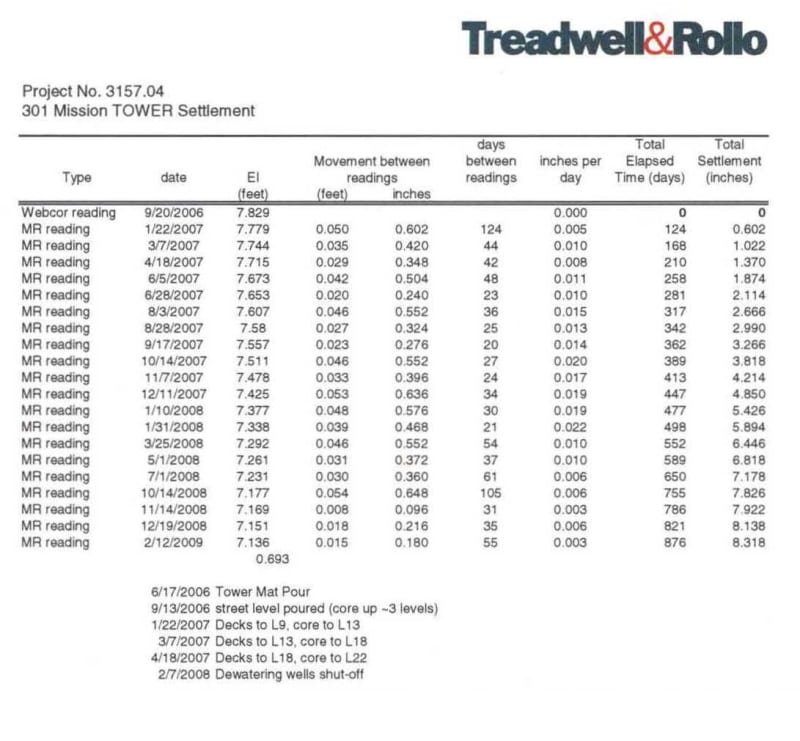
Apart from the Millennium Tower being, at one time, the tallest, heaviest building west of the Mississippi, it can possibly claim another first. I'm not really sure. Has there ever been another building to exploit an "Outrigger/Cellular Box Grade Beam"? Okay, it wasn't really intended to be an Outrigger/Cellular Box Grade Beam? It was supposed to be a 3 foot thick cantilever slab off the south end (Transbay terminal side) of the 10 ft thick mat that would fly over a 15H?x15Wx100L ft., PG&E utility vault but once the building started sinking there was going to come a point where the compacted back-fill would push back. You can see the vault in these two photos.
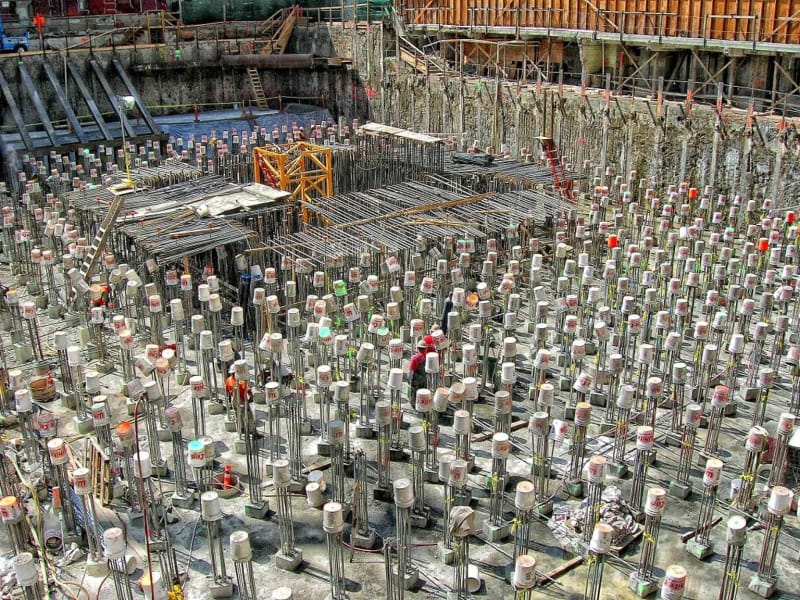
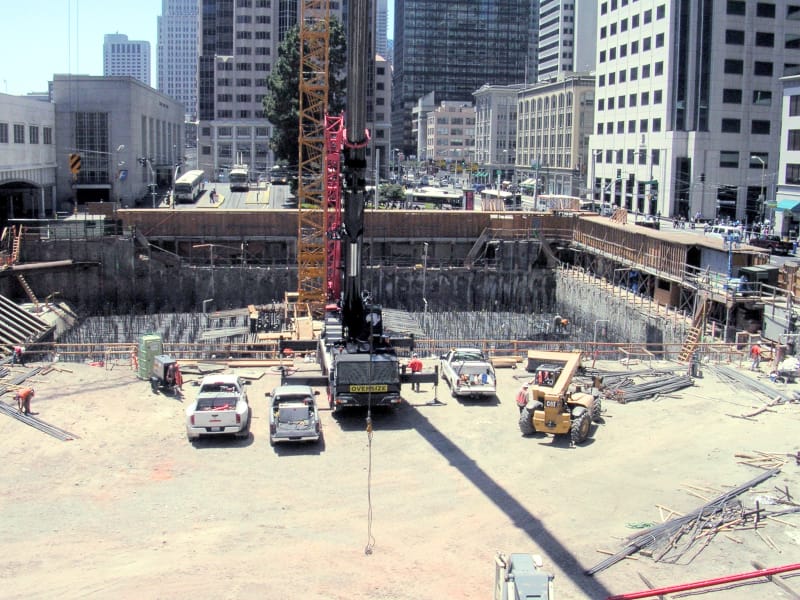
In the document package at the SF Gov website for the public hearing by the Government Audit and Oversight Committee, initiated by SF Supervisor Aaron Peskin, there is vague mention of the PG&E utility vault and the Millennium Partner's legal team geotechnical engineers, Sage Engineer's efforts to calculate the subgrade modulus of the soil beneath the vault. Later in the SG&H 2017 supplemental seismic report, it is less clear, stating Sage is working on providing the subgrade modulus for the "soil supported" cantilever slab at the south end of the mat foundation.
It would be easy for most people to be confused as to what is being discussed in either instance because the B1 basement of the tower was also constructed with an almost identical PG&E utility vault directly over the one that was buried beneath the former 129 Fremont St. before the properties on the block were merged into 301 Mission for the condo project. Sage Engineers & SG&H might want to consider 4.3 to 4.6 x 10-6 as a modulus. Not that I have any basis for suggesting a proximate soil subgrade modulus but I think that might be a reasonable approximation of the Young's Modulus of 5000 psi compressive strength concrete.
The subgrade modulus is indeed a tricky number. The shoring wall for the Transbay terminal is directly along the south (100 ft side) of the PG&E vault and is 90+ feet deep, followed by the buttress wall extended to bedrock, while the CDSM tower/podium shoring wall is 80 feet deep & directly at the east end of the vault, the north side of the vault has 10 to 15 feet of open soil (under a portion of the cantilever slab/B1 Basement) between the vault and the mat foundation and the mass of the soil enveloped by the piles below the mat. Then only portion not completely influenced by confinement is the west end facing Fremont St. here the shoring wall is no where near as deep, perhaps 35 to 40 feet SF Datum.
Using a round number of 100 pcf for the soil removed for the old vault and that of the new tower basement, the soil supporting the old PG&E vault is about 2.5 to 3 million pounds light of equilibrium. If one was looking for a reason why the building was tilting to the north..., a type 3 lever & fulcrum (correct me if I'm wrong) might have something to do with it. "Outrigger/Cellular Box Grade Beam"~®" any suggestions for a more elegant name?
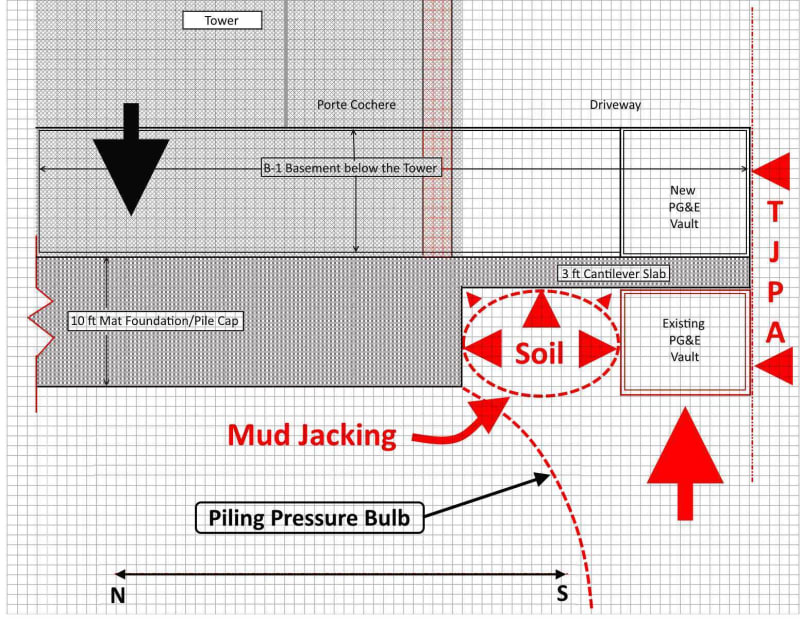
Speaking of equilibrium, once the excavation for the tower basement was fully compensated by upper floors, the building was "by weight" perhaps only 3 stories tall when it started sinking.
One really has to wonder what is being done to resolve this issue since PG&E needs to show due diligence in defending their easement rights. When ARUP inspected the basement of Millennium Tower, they were not granted access to the new PG&E vault in the B1 basement. When one considers that half of the 103 crack monitors are positioned on this end of the building, where the 3 foot cantilever slab joins & prys away at the mat foundation, you have to wonder what the condition of the concrete inside of the vault looks like. There was some strange activity along the 301 Mission/TJPA property line back in March 2017. The underground work looks like it extends beyond the 5 ft TJPA/301 Mission easement but there doesn't seem to be a permit at SFPUC, SFDBI or SFDPW. I would hate to think the TJPA & Millennium were doing corrective work through back channels without the public knowing who is paying for what.
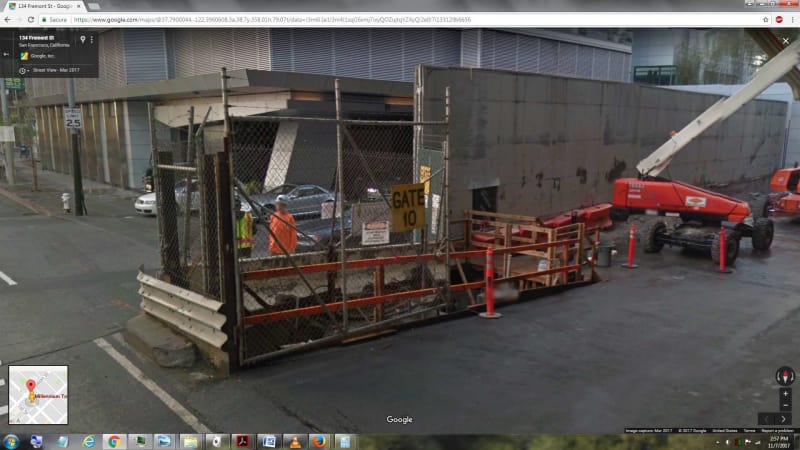
The screen wall in the photo approximately represents the limits of the 5 ft TJPA easement onto the 301 Mission property line.
Both DeSimone & SG&H have stated that the basement walls of the tower play no role in the seismic response of the tower and while this may be true, it still doesn't address the issue that the cracks in the basement walls of the tower are structural cracks and the walls of the basement are 15 foot high retaining walls. Unless all the service lines leading into the tower arrive above ground, it cannot be stated that the tower is prepared for a large earthquake. For a little perspective, if you assume that what is above the basement was just a 5 story wood frame condo building, then the condition of the basement walls would have resulted in this structure being yellow tagged after the Loma Prieta earthquake. So how did a really heavy 58 story building with a "Yellow Tag" grade basement get an occupancy permit? There are probably upwards of a thousand property owners that could attest to having to seek out an engineer and take corrective action for damage sustained equal to what can be seen in the basement of 301 Mission. Maybe San Francisco City Hall can get the world's first Office of Resiliency to explain.

If one takes a look at the pile driving record for the tower and maps it out in excel it really doesn't look too bad. There are vulnerabilities (soft piles) and the mat of the heavy tower does deflect where these piles are located but it is tough to conclude that these appear in sufficient numbers, in group to explain the westerly tilt. At least not without some precipitating cause. Treadwell & Rollo indicated in their letter responding to an inquiry by SFDBI's Raymond Lui, that the extended dewatering of the soil during excavation might explain the settlement, it seems that would be at least one possibility. Fremont St & Mission St both appear to have settled at some point proximate to the timeline of the project and Webcor Builders took out a SFDPW permit to reset manholes on Mission St in 2009 while closing up the project. The manholes on Mission St have been paved over & later reset at least once again since 2009.
What about the shoring walls of the tower? Do they contribute to the tilting? The shoring walls on Mission & Fremont are comparatively shallow, perhaps -35 to -40 feet deep from SF Datum(the base of the tower mat is -24 ft). The eastern shoring wall is sandwiched like a keel, between the tower & podium is between at 80 & 90 feet deep and backed up by the 57 ft deep x 5 level basement parking garage. Finally the south end of the tower doesn't have a shoring wall but does have a concrete bubble beneath it bobbing on Young Bay Mud.
In one of my early posts I pointed out the 40 or so, "strong-backs", for lack of a better name, that overlay the top of the soldier piles on the tower/podium shoring wall. I assumed they were tied to the tower mat foundation and welded to the soldier piles to provide additional cantilever support during early excavation. Later I realized they needed to float, in order for the building to be allowed to settle evenly. So were they floating or were they welded to the soldier piles? The tower was at 42 floors when the last of the cross bracing struts & strong-backs were removed. The lack of soil directly behind the upper tier of lagging caught my eye early on as well but I don't know how much to attach to this. Did the soil drop from the bottom of the mat foundation as a result of aggressive dewatering? The following photo is from end of May or early June 2007. The building had settled about 2 inches.
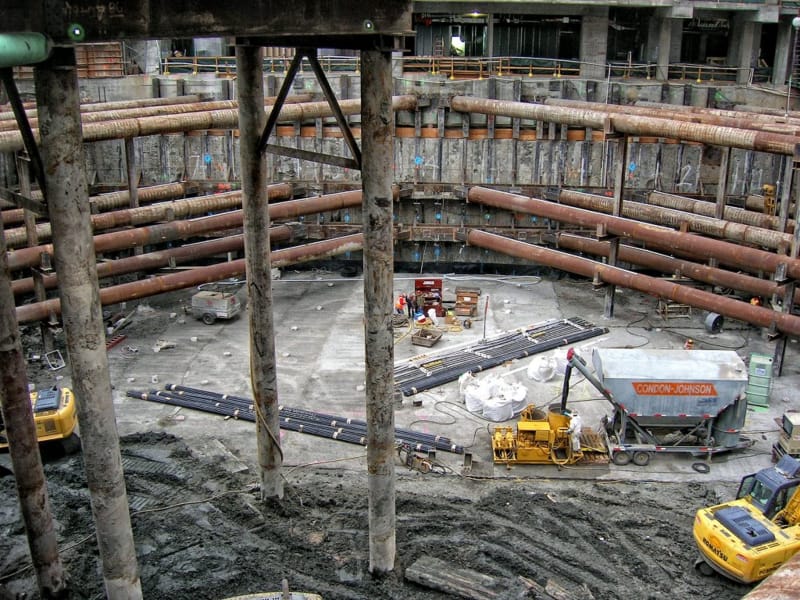
SFDBI when questioned by SF Supervisor Aaron Peskin about why they did not consider the impending Transbay Center project in their evaluation of the Millennium Tower foundation, responded that they only review what is within the property lines. This makes sense but in the case of 301 Mission, the very concise wording of the SF planning permit, right up to the last paragraph of the planning motion, called for the "Joimt Use" of the property. In essence the Transbay Center was figuratively 5 feet inside the 301 Mission project property line. "Joimt Use" is legal lingo commonly found in easement agreements. The easement agreement between Mission Street Development aka Millennium Tower & Transbay (TJPA) wasn't executed until after the tower was built but in 2002 when the TJPA was consolidating their options for the path of the Transbay Center rail alignment with the site of the old Transbay Terminal, there was a fair deal of back & forth between Mission Street Development, DeSimone, Handel Arch & Caltrans & the TJPA about alternatives & the 301 Mission Tower project, including some fairly detailed schematics. (It somewhat calls into question Myers Dev. argument that the TJPA was unresponsive to communicating in like fashion regarding 80 Natoma). Ultimately, the planning motion that approved the 301 Mission St. development was based on Mission Street Development's "PROJECT SPONSOR PREFERRED"(Alternate E-1) citing joint use & incorporating a 5 foot wide TJPA easement along the length of the southern 301 Mission property line.
SFDBI's response came with reference to California Civil Code 832 pointing to “Each Coterminous Owner is Entitled to Lateral & Subadjacent Support” as cause to disregard development on adjoining property when evaluating the merits of an individual project. One problem for SFDBI is that for more than 20 years the SF Planning Dept. has been issuing planning permits that call for areal groundwater & settlement monitoring, specifically citing the Special Inspections section of the building code. The 80 Natoma project specifically called out for a recommendation by the Geotechnical Engineer regarding groundwater & settlement monitoring as a "Condition". In the case of 301 Mission, Mission Street Development volunteered, stating they would follow the recommendations of presented in the Final Geotechincal Report for the 301 Mission project. Treadwell & Rollo had a long list of recommendations, including groundwater & settlement monitoring. I think it is fair to say that streets settling & PG&E utility vaults with buildings resting on top of them represent Environmental Impacts that SFDBI has failed to consider. Apparently because the street is beyond the property line, it is the City of San Francisco & taxpayers responsibility to provide "Lateral & Subadjacent Support".
Far from SFDBI finding safe harbor in citing CVC 832, they may have isolated themselves. As a Coterminous Owner, the Transbay Center was equally entitled to "Lateral & Subadjacent Support", perhaps more so because the 301 Mission St project, at least on paper does not receive clearance for an SFDBI building permit, vis-a-vis the SF planning motion approving the 301 Mission St development without the inclusion of the "PROJECT SPONSOR PREFERRED" & "Joint Use" stipulation. When you delve into the history of Lateral & Subadjacent Support, another phase pops up and that is "soil in its natural state". In the case of the Coterminous properties of 301 Mission & the Transbay Center, the natural state would historically be soil in a state of rest. The last time it might be said to have moved was 1989. But by virtue of the continued settlement problems at 301 Mission brought about by construction on the property, which precede the Transbay Center excavation, the soils of the 301 Mission street property cannot really be consider to be any longer at rest. One could actually look at the TJPA shoring wall and subsequent Buttress Wall as extraordinary remedial measures to protect the TJPA project from the instability of the ground of the adjoining property.
Essentially, the property at 301 Mission was like a car that hadn't moved since 1989, the tires deflated & having flat spots, the oil pan with sludge, the brakes possibly rusted a bit to the calipers or discs. Even a car that sits overnight is harder to push the next day than one that has just come to a complete stop. The Millennium team not only got the car rolling but when they all stopped to celebrate, it kept rolling. The TJPA just represents a gentle downward slope in the road. It all comes down to the coefficients of static and kinetic friction. It is far easier to push a car that is already rolling than to get the car rolling in the first place. Whatever minuscule portion of responsibility could be attributed to the TJPA excavation would require some very elaborate modelling.
Then again the Transbay excavation itself can only effect soil at a given distance from the excavation. The excavation was 60 feet deep. At 30 feet if you draw a 45 degree angle back up and towards the tower, it intersects the side of the 10 ft mat foundation. That is why Millennium bangs away at dewatering because the areal effects of dewatering can be larger. It is just that there was so little rain fall during the Transbay excavation, it may be difficult to point to groundwater gauges and blame the TJPA. 40% of downtown San Francisco's ground water comes from leaky sewer pipes. Welcome to the Golden State!
The Millennium residents cite the Non-disclosure Agreement between the TJPA & Millennium but the responsibility was Millennium's. For the TJPA to say anything that would diminish the value of the 301 Mission project would have been grounds for a lawsuit. It doesn't help that the attorneys representing the Transbay Joint Powers Authority were from the City of San Francisco Attorney's Office much to the objection of many at the TJPA. No doubt SFDBI was worried about being seen as a party that could damage the prospects for the tower project but they still had a responsibility to see the cracks in the basement structurally repaired before issuing a certificate of final completion. There is no way around the fact that the certificate was improperly issued.
In 2014 the City of SF replaced the sewer line in Fremont St, claiming it was old and had probably needed to be replaced for some time but in 2011 in preparation for the Transbay Center project, utility lines were run immediately adjacent to the sewer line and if it was in such a bad state, it would have been dealt with then. It is more likely that the sewer line was damaged by the rotation of the Millennium Tower. Here is an April 2014 on the Microsoft Map page suggesting rotation, more are found on Google Maps in Nov. 2014 & later. The curb in front of the bus stop on Fremont St was in a preliminary state of failure. Even for the curb to be in this condition in 2014 took at least a year or two for this degree of deterioration to manifest. It has progressively been snapping like a candy cane for the last 4 years. It begs the question, what do the people at the SFPUC & SFDPW know and how long have they known. Has anyone been hurt at this bus stop? Why has it gone untended for so long? The building appears to be plowing a 35 foot wall of fill and mud in front of it.
April 2014
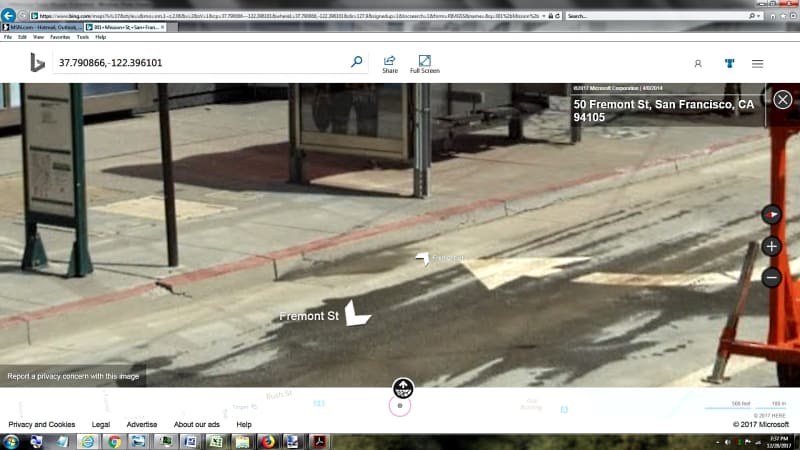
Nov 2014
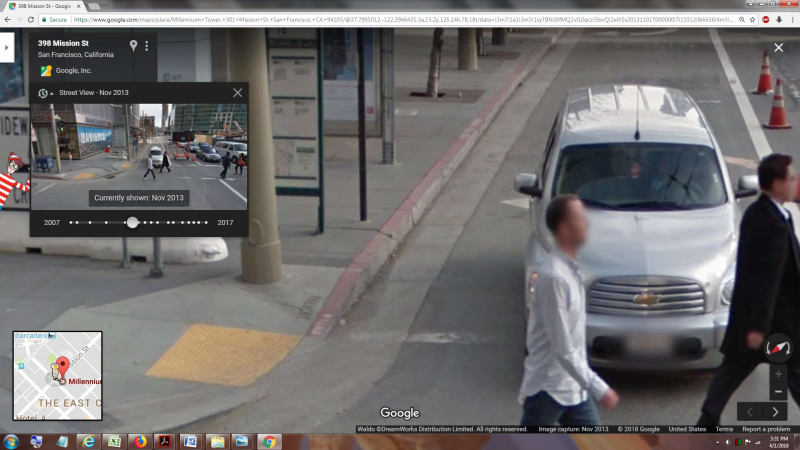
July 2015
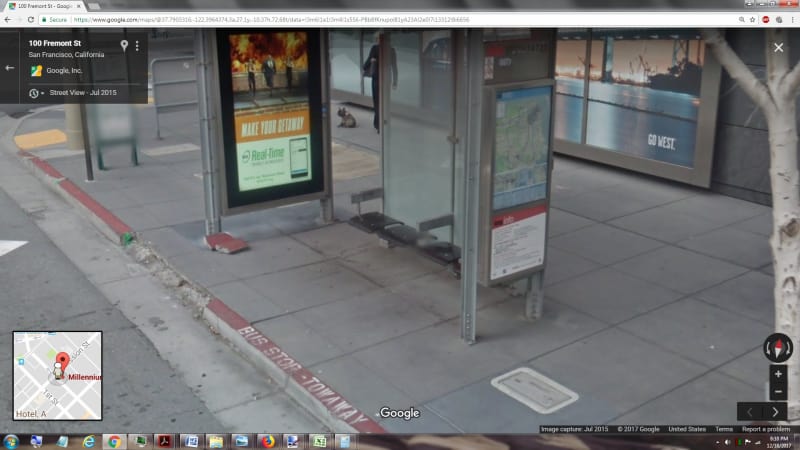
Oct 2017
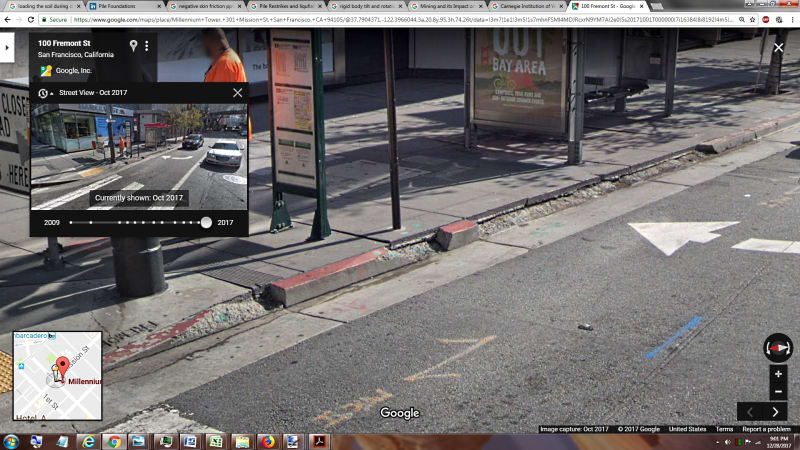
I'm sure there is more that I have left out since my last post but this is the bulk of what I've learned. In fairness to Millennium Partners, I do feel for them. In their preliminary EIR, they had plans to move forward with the project in 2002/2003, maybe they were hoping to open under a Luxury Hotel Brand, maybe the PG&E Land Office & utility vault was holding the project up. When the project was finally approved by the SF Planning Commission in July 2003, it still had a 4 story basement/parking garage beneath the tower. The Treadwell & Rollo soils investigation is almost entirely based on the data from 2001/2002 & a 4 level partially compensated mat foundation. In May 2004 Niaz A. Nazir Ph.D. - Managing Principal for DeSimone Consulting Engineers SF & Chief Engineer for 301 Mission Project passed away unexpectedly. Enter Derrick Rhoorda to take over for DeSimone. When you consider that Millennium Partners subsequently brought in Jack Moehle to make sure the project was up to snuff, you might begin to appreciate how Millennium Partners might feel like they did their best and are not happy about the outcome.
SFDBI really is the Reno 911 of Building Inspection Departments. If you have a weekend to burn, you won't be disappointed reading San Francisco news items about the scandals that permeate both SFDBI & the Planning Commission. I think what is perhaps the most stunning and overlooked part of the Millennium Tower debacle is that SFDBI does not have a Geotechnical Engineer or Civil Engineer to pass muster on Chapter 18 of the Building Code. They don't even have easily to find guidance or an Administrative Bulletin on their website concerning Geotechnical Requirements. There was an effort from 2001 to 2004 to craft a Geotechnical Administrative Bulletin but it died in the Structuaral Subcommittee of the Code Advisory Committee in the hands of Hanson Tom. He had been asked to invite Frank Rollo to address the Structural Subcommittee regarding a Geotechnical Administrative Bulletin. Did he make the invite? If I was an SF homeowner who paid a ridiculous sum for home in San Francisco & was required to higher a Geotechnical Engineer to put an addition on my home, only for SFDBI to ignore the work in the report I would not be happy.
San Francisco has the Maher Ordinance for portions of San Francisco that are built on bay fill & they have Supervisor Aaron Peskin's Slope Protection Ordinance but they don't have anyone on staff that has the required knowledge & experience to actually review a Geotechnical Report. The city with the most infamous & dramatic examples of what earthquakes can do to a city doesn't feel compelled to hire one Geotechnical Engineer at SFDBI. Since Millennium Tower they have crafted, not a Geotechnical Administrative Bulletin but a more rigorous Structural - Tall Building & Performance Design Administrative Bulletin, essentially engineering their way around, doing the obvious. Now, they require not one but TWO geotechnical engineers or some such nonsense. Seattle, Los Angeles, San Diego all have well developed Geotechnical Teams in their building departments but not San Francisco. Even San Jose, which doesn't have much need for a Geotechnical Engineer has a City Geologist that decides if a project requires deeper scrutiny.
It is not just SFDBI, it is the City. A look an employment website confirms the Bay Area has more Geotechial Engineers than anywhere else in the world but when SF needed one for the 301 Seismic Safety Committee PEER Review, apparently the only one they could find was a former founding employee, 16 year alumnus of Treadwell & Rollo who started out with Frank Rollo Sr. at Harding/Lawson pre-1989.
There was a time that a former SFDBI employee was forging an Architect's & a Structural Engineer's seal on documents submitted to SFDBI. Supposedly it took years for his former colleagues to become suspicious. If he had chosen a Geotechnical Engineers seal, he might still be at it.
Before the City of San Francisco decides to waste any more time on Administrative Bulletins, they need to hire a Geotechnical Engineer. It also doesn't take an Administrative Bulletin to require that going forward all Major Buildings & PEER Review Kick-off meeting will be attended by all engineers of record on the project, including the Geotech. The City of San Francisco deservedly should have to deal with this mess on its own. The TJPA did all their due diligence.
The SG&H 2017 Seismic Report Supplement largely crafted to address the suggestion by Sen, Dianne Feinstein that a committee be formed to investigate the troubles at 301 Mission is a bit sloppy, considering the company that authored it & the people impaneled by the City to review the data. The Long-term Static Axial Pile capacity is described at having it's lowest capacity to the North & East but it appears to be to the North & West, which is an area that SFDBI expressed concern about. Also, the description of the tops of the piles in the report has the numbers jumbled in two different parts of the report and the description is not in agreement with the shop drawings supplied by the pile producer. While most of the numbers on the pile shop drawing are in mathematical agreement, there is a number shown at the sum of the strands that is clearly not correct.
SG&H describes the piles as having 8ea x 23ft-6in of #8 or #9, suggesting 12ft-3in could be removed with 12ft-3in left to develop pile capacity. In fact there are 4ea x 23ft-6in of #8 & 4 ea x 7.5ft #9 bars grouted into 17.5ft sleeves. It isn't so much that there are a large number of piles that were cut but that SG&H really fails to explain with clarity how the piles are up to the task or how many are deficient. There was something else that was off about the report but it escapes me at the moment.
It looks like The Millennium Tower HOA is moving forward with an objective to stabilized the Millennium Tower. LERA & Swinerton Builders are the team overseeing the work. Documents on file for 301 Mission at the SF Planning Dept. website show they will be coring possibly two penetrations through the 10 foot mat foundation at the north end of the tower, approx mid tower.
They will also be opening up the the wall of the parking structure at parking level 2, cutting two 3 ft by 3 ft openings, in order to determine if the tower has come to rest on the soldier piles of the CDSM shoring wall between the tower & the podium structure. In Treadwell & Rollo's 2005 Geotechnical Report, T&R had recommended that since the CDSM shoring wall was to be directly beneath the mat foundation, the shoring wall should be at least 12 inches below the mat, to avoid interference.
The tower may or may not be resting on the shoring wall. If it is, that will at least give engineers something to think about but if it is not, then they will have to consider the consequences and how much time they have before it does and matters become more critical. The soldier piles were about 1 foot higher than the CDSM shoring. In hindsight one would think the developer's team ought to have given thought to cutting the soldier piles down, since Treadwell & Rollo's second estimate for additional settlement of the tower was still a large number AND they knew or should have, well before the last level of the parking structure was poured, that shoring wall interference could be a factor. As soon as the last struts of the podium were removed the tower settlement accelerated. The building was sinking at 0.020 inches a day.

Apart from the Millennium Tower being, at one time, the tallest, heaviest building west of the Mississippi, it can possibly claim another first. I'm not really sure. Has there ever been another building to exploit an "Outrigger/Cellular Box Grade Beam"? Okay, it wasn't really intended to be an Outrigger/Cellular Box Grade Beam? It was supposed to be a 3 foot thick cantilever slab off the south end (Transbay terminal side) of the 10 ft thick mat that would fly over a 15H?x15Wx100L ft., PG&E utility vault but once the building started sinking there was going to come a point where the compacted back-fill would push back. You can see the vault in these two photos.


In the document package at the SF Gov website for the public hearing by the Government Audit and Oversight Committee, initiated by SF Supervisor Aaron Peskin, there is vague mention of the PG&E utility vault and the Millennium Partner's legal team geotechnical engineers, Sage Engineer's efforts to calculate the subgrade modulus of the soil beneath the vault. Later in the SG&H 2017 supplemental seismic report, it is less clear, stating Sage is working on providing the subgrade modulus for the "soil supported" cantilever slab at the south end of the mat foundation.
It would be easy for most people to be confused as to what is being discussed in either instance because the B1 basement of the tower was also constructed with an almost identical PG&E utility vault directly over the one that was buried beneath the former 129 Fremont St. before the properties on the block were merged into 301 Mission for the condo project. Sage Engineers & SG&H might want to consider 4.3 to 4.6 x 10-6 as a modulus. Not that I have any basis for suggesting a proximate soil subgrade modulus but I think that might be a reasonable approximation of the Young's Modulus of 5000 psi compressive strength concrete.
The subgrade modulus is indeed a tricky number. The shoring wall for the Transbay terminal is directly along the south (100 ft side) of the PG&E vault and is 90+ feet deep, followed by the buttress wall extended to bedrock, while the CDSM tower/podium shoring wall is 80 feet deep & directly at the east end of the vault, the north side of the vault has 10 to 15 feet of open soil (under a portion of the cantilever slab/B1 Basement) between the vault and the mat foundation and the mass of the soil enveloped by the piles below the mat. Then only portion not completely influenced by confinement is the west end facing Fremont St. here the shoring wall is no where near as deep, perhaps 35 to 40 feet SF Datum.
Using a round number of 100 pcf for the soil removed for the old vault and that of the new tower basement, the soil supporting the old PG&E vault is about 2.5 to 3 million pounds light of equilibrium. If one was looking for a reason why the building was tilting to the north..., a type 3 lever & fulcrum (correct me if I'm wrong) might have something to do with it. "Outrigger/Cellular Box Grade Beam"~®" any suggestions for a more elegant name?

Speaking of equilibrium, once the excavation for the tower basement was fully compensated by upper floors, the building was "by weight" perhaps only 3 stories tall when it started sinking.
One really has to wonder what is being done to resolve this issue since PG&E needs to show due diligence in defending their easement rights. When ARUP inspected the basement of Millennium Tower, they were not granted access to the new PG&E vault in the B1 basement. When one considers that half of the 103 crack monitors are positioned on this end of the building, where the 3 foot cantilever slab joins & prys away at the mat foundation, you have to wonder what the condition of the concrete inside of the vault looks like. There was some strange activity along the 301 Mission/TJPA property line back in March 2017. The underground work looks like it extends beyond the 5 ft TJPA/301 Mission easement but there doesn't seem to be a permit at SFPUC, SFDBI or SFDPW. I would hate to think the TJPA & Millennium were doing corrective work through back channels without the public knowing who is paying for what.

The screen wall in the photo approximately represents the limits of the 5 ft TJPA easement onto the 301 Mission property line.
Both DeSimone & SG&H have stated that the basement walls of the tower play no role in the seismic response of the tower and while this may be true, it still doesn't address the issue that the cracks in the basement walls of the tower are structural cracks and the walls of the basement are 15 foot high retaining walls. Unless all the service lines leading into the tower arrive above ground, it cannot be stated that the tower is prepared for a large earthquake. For a little perspective, if you assume that what is above the basement was just a 5 story wood frame condo building, then the condition of the basement walls would have resulted in this structure being yellow tagged after the Loma Prieta earthquake. So how did a really heavy 58 story building with a "Yellow Tag" grade basement get an occupancy permit? There are probably upwards of a thousand property owners that could attest to having to seek out an engineer and take corrective action for damage sustained equal to what can be seen in the basement of 301 Mission. Maybe San Francisco City Hall can get the world's first Office of Resiliency to explain.

If one takes a look at the pile driving record for the tower and maps it out in excel it really doesn't look too bad. There are vulnerabilities (soft piles) and the mat of the heavy tower does deflect where these piles are located but it is tough to conclude that these appear in sufficient numbers, in group to explain the westerly tilt. At least not without some precipitating cause. Treadwell & Rollo indicated in their letter responding to an inquiry by SFDBI's Raymond Lui, that the extended dewatering of the soil during excavation might explain the settlement, it seems that would be at least one possibility. Fremont St & Mission St both appear to have settled at some point proximate to the timeline of the project and Webcor Builders took out a SFDPW permit to reset manholes on Mission St in 2009 while closing up the project. The manholes on Mission St have been paved over & later reset at least once again since 2009.
What about the shoring walls of the tower? Do they contribute to the tilting? The shoring walls on Mission & Fremont are comparatively shallow, perhaps -35 to -40 feet deep from SF Datum(the base of the tower mat is -24 ft). The eastern shoring wall is sandwiched like a keel, between the tower & podium is between at 80 & 90 feet deep and backed up by the 57 ft deep x 5 level basement parking garage. Finally the south end of the tower doesn't have a shoring wall but does have a concrete bubble beneath it bobbing on Young Bay Mud.
In one of my early posts I pointed out the 40 or so, "strong-backs", for lack of a better name, that overlay the top of the soldier piles on the tower/podium shoring wall. I assumed they were tied to the tower mat foundation and welded to the soldier piles to provide additional cantilever support during early excavation. Later I realized they needed to float, in order for the building to be allowed to settle evenly. So were they floating or were they welded to the soldier piles? The tower was at 42 floors when the last of the cross bracing struts & strong-backs were removed. The lack of soil directly behind the upper tier of lagging caught my eye early on as well but I don't know how much to attach to this. Did the soil drop from the bottom of the mat foundation as a result of aggressive dewatering? The following photo is from end of May or early June 2007. The building had settled about 2 inches.

SFDBI when questioned by SF Supervisor Aaron Peskin about why they did not consider the impending Transbay Center project in their evaluation of the Millennium Tower foundation, responded that they only review what is within the property lines. This makes sense but in the case of 301 Mission, the very concise wording of the SF planning permit, right up to the last paragraph of the planning motion, called for the "Joimt Use" of the property. In essence the Transbay Center was figuratively 5 feet inside the 301 Mission project property line. "Joimt Use" is legal lingo commonly found in easement agreements. The easement agreement between Mission Street Development aka Millennium Tower & Transbay (TJPA) wasn't executed until after the tower was built but in 2002 when the TJPA was consolidating their options for the path of the Transbay Center rail alignment with the site of the old Transbay Terminal, there was a fair deal of back & forth between Mission Street Development, DeSimone, Handel Arch & Caltrans & the TJPA about alternatives & the 301 Mission Tower project, including some fairly detailed schematics. (It somewhat calls into question Myers Dev. argument that the TJPA was unresponsive to communicating in like fashion regarding 80 Natoma). Ultimately, the planning motion that approved the 301 Mission St. development was based on Mission Street Development's "PROJECT SPONSOR PREFERRED"(Alternate E-1) citing joint use & incorporating a 5 foot wide TJPA easement along the length of the southern 301 Mission property line.
SFDBI's response came with reference to California Civil Code 832 pointing to “Each Coterminous Owner is Entitled to Lateral & Subadjacent Support” as cause to disregard development on adjoining property when evaluating the merits of an individual project. One problem for SFDBI is that for more than 20 years the SF Planning Dept. has been issuing planning permits that call for areal groundwater & settlement monitoring, specifically citing the Special Inspections section of the building code. The 80 Natoma project specifically called out for a recommendation by the Geotechnical Engineer regarding groundwater & settlement monitoring as a "Condition". In the case of 301 Mission, Mission Street Development volunteered, stating they would follow the recommendations of presented in the Final Geotechincal Report for the 301 Mission project. Treadwell & Rollo had a long list of recommendations, including groundwater & settlement monitoring. I think it is fair to say that streets settling & PG&E utility vaults with buildings resting on top of them represent Environmental Impacts that SFDBI has failed to consider. Apparently because the street is beyond the property line, it is the City of San Francisco & taxpayers responsibility to provide "Lateral & Subadjacent Support".
Far from SFDBI finding safe harbor in citing CVC 832, they may have isolated themselves. As a Coterminous Owner, the Transbay Center was equally entitled to "Lateral & Subadjacent Support", perhaps more so because the 301 Mission St project, at least on paper does not receive clearance for an SFDBI building permit, vis-a-vis the SF planning motion approving the 301 Mission St development without the inclusion of the "PROJECT SPONSOR PREFERRED" & "Joint Use" stipulation. When you delve into the history of Lateral & Subadjacent Support, another phase pops up and that is "soil in its natural state". In the case of the Coterminous properties of 301 Mission & the Transbay Center, the natural state would historically be soil in a state of rest. The last time it might be said to have moved was 1989. But by virtue of the continued settlement problems at 301 Mission brought about by construction on the property, which precede the Transbay Center excavation, the soils of the 301 Mission street property cannot really be consider to be any longer at rest. One could actually look at the TJPA shoring wall and subsequent Buttress Wall as extraordinary remedial measures to protect the TJPA project from the instability of the ground of the adjoining property.
Essentially, the property at 301 Mission was like a car that hadn't moved since 1989, the tires deflated & having flat spots, the oil pan with sludge, the brakes possibly rusted a bit to the calipers or discs. Even a car that sits overnight is harder to push the next day than one that has just come to a complete stop. The Millennium team not only got the car rolling but when they all stopped to celebrate, it kept rolling. The TJPA just represents a gentle downward slope in the road. It all comes down to the coefficients of static and kinetic friction. It is far easier to push a car that is already rolling than to get the car rolling in the first place. Whatever minuscule portion of responsibility could be attributed to the TJPA excavation would require some very elaborate modelling.
Then again the Transbay excavation itself can only effect soil at a given distance from the excavation. The excavation was 60 feet deep. At 30 feet if you draw a 45 degree angle back up and towards the tower, it intersects the side of the 10 ft mat foundation. That is why Millennium bangs away at dewatering because the areal effects of dewatering can be larger. It is just that there was so little rain fall during the Transbay excavation, it may be difficult to point to groundwater gauges and blame the TJPA. 40% of downtown San Francisco's ground water comes from leaky sewer pipes. Welcome to the Golden State!
The Millennium residents cite the Non-disclosure Agreement between the TJPA & Millennium but the responsibility was Millennium's. For the TJPA to say anything that would diminish the value of the 301 Mission project would have been grounds for a lawsuit. It doesn't help that the attorneys representing the Transbay Joint Powers Authority were from the City of San Francisco Attorney's Office much to the objection of many at the TJPA. No doubt SFDBI was worried about being seen as a party that could damage the prospects for the tower project but they still had a responsibility to see the cracks in the basement structurally repaired before issuing a certificate of final completion. There is no way around the fact that the certificate was improperly issued.
In 2014 the City of SF replaced the sewer line in Fremont St, claiming it was old and had probably needed to be replaced for some time but in 2011 in preparation for the Transbay Center project, utility lines were run immediately adjacent to the sewer line and if it was in such a bad state, it would have been dealt with then. It is more likely that the sewer line was damaged by the rotation of the Millennium Tower. Here is an April 2014 on the Microsoft Map page suggesting rotation, more are found on Google Maps in Nov. 2014 & later. The curb in front of the bus stop on Fremont St was in a preliminary state of failure. Even for the curb to be in this condition in 2014 took at least a year or two for this degree of deterioration to manifest. It has progressively been snapping like a candy cane for the last 4 years. It begs the question, what do the people at the SFPUC & SFDPW know and how long have they known. Has anyone been hurt at this bus stop? Why has it gone untended for so long? The building appears to be plowing a 35 foot wall of fill and mud in front of it.
April 2014

Nov 2014

July 2015

Oct 2017

I'm sure there is more that I have left out since my last post but this is the bulk of what I've learned. In fairness to Millennium Partners, I do feel for them. In their preliminary EIR, they had plans to move forward with the project in 2002/2003, maybe they were hoping to open under a Luxury Hotel Brand, maybe the PG&E Land Office & utility vault was holding the project up. When the project was finally approved by the SF Planning Commission in July 2003, it still had a 4 story basement/parking garage beneath the tower. The Treadwell & Rollo soils investigation is almost entirely based on the data from 2001/2002 & a 4 level partially compensated mat foundation. In May 2004 Niaz A. Nazir Ph.D. - Managing Principal for DeSimone Consulting Engineers SF & Chief Engineer for 301 Mission Project passed away unexpectedly. Enter Derrick Rhoorda to take over for DeSimone. When you consider that Millennium Partners subsequently brought in Jack Moehle to make sure the project was up to snuff, you might begin to appreciate how Millennium Partners might feel like they did their best and are not happy about the outcome.
SFDBI really is the Reno 911 of Building Inspection Departments. If you have a weekend to burn, you won't be disappointed reading San Francisco news items about the scandals that permeate both SFDBI & the Planning Commission. I think what is perhaps the most stunning and overlooked part of the Millennium Tower debacle is that SFDBI does not have a Geotechnical Engineer or Civil Engineer to pass muster on Chapter 18 of the Building Code. They don't even have easily to find guidance or an Administrative Bulletin on their website concerning Geotechnical Requirements. There was an effort from 2001 to 2004 to craft a Geotechnical Administrative Bulletin but it died in the Structuaral Subcommittee of the Code Advisory Committee in the hands of Hanson Tom. He had been asked to invite Frank Rollo to address the Structural Subcommittee regarding a Geotechnical Administrative Bulletin. Did he make the invite? If I was an SF homeowner who paid a ridiculous sum for home in San Francisco & was required to higher a Geotechnical Engineer to put an addition on my home, only for SFDBI to ignore the work in the report I would not be happy.
San Francisco has the Maher Ordinance for portions of San Francisco that are built on bay fill & they have Supervisor Aaron Peskin's Slope Protection Ordinance but they don't have anyone on staff that has the required knowledge & experience to actually review a Geotechnical Report. The city with the most infamous & dramatic examples of what earthquakes can do to a city doesn't feel compelled to hire one Geotechnical Engineer at SFDBI. Since Millennium Tower they have crafted, not a Geotechnical Administrative Bulletin but a more rigorous Structural - Tall Building & Performance Design Administrative Bulletin, essentially engineering their way around, doing the obvious. Now, they require not one but TWO geotechnical engineers or some such nonsense. Seattle, Los Angeles, San Diego all have well developed Geotechnical Teams in their building departments but not San Francisco. Even San Jose, which doesn't have much need for a Geotechnical Engineer has a City Geologist that decides if a project requires deeper scrutiny.
It is not just SFDBI, it is the City. A look an employment website confirms the Bay Area has more Geotechial Engineers than anywhere else in the world but when SF needed one for the 301 Seismic Safety Committee PEER Review, apparently the only one they could find was a former founding employee, 16 year alumnus of Treadwell & Rollo who started out with Frank Rollo Sr. at Harding/Lawson pre-1989.
There was a time that a former SFDBI employee was forging an Architect's & a Structural Engineer's seal on documents submitted to SFDBI. Supposedly it took years for his former colleagues to become suspicious. If he had chosen a Geotechnical Engineers seal, he might still be at it.
Before the City of San Francisco decides to waste any more time on Administrative Bulletins, they need to hire a Geotechnical Engineer. It also doesn't take an Administrative Bulletin to require that going forward all Major Buildings & PEER Review Kick-off meeting will be attended by all engineers of record on the project, including the Geotech. The City of San Francisco deservedly should have to deal with this mess on its own. The TJPA did all their due diligence.
The SG&H 2017 Seismic Report Supplement largely crafted to address the suggestion by Sen, Dianne Feinstein that a committee be formed to investigate the troubles at 301 Mission is a bit sloppy, considering the company that authored it & the people impaneled by the City to review the data. The Long-term Static Axial Pile capacity is described at having it's lowest capacity to the North & East but it appears to be to the North & West, which is an area that SFDBI expressed concern about. Also, the description of the tops of the piles in the report has the numbers jumbled in two different parts of the report and the description is not in agreement with the shop drawings supplied by the pile producer. While most of the numbers on the pile shop drawing are in mathematical agreement, there is a number shown at the sum of the strands that is clearly not correct.
SG&H describes the piles as having 8ea x 23ft-6in of #8 or #9, suggesting 12ft-3in could be removed with 12ft-3in left to develop pile capacity. In fact there are 4ea x 23ft-6in of #8 & 4 ea x 7.5ft #9 bars grouted into 17.5ft sleeves. It isn't so much that there are a large number of piles that were cut but that SG&H really fails to explain with clarity how the piles are up to the task or how many are deficient. There was something else that was off about the report but it escapes me at the moment.
ornerynorsk
Industrial
Awesome post, epoxybot! Very informative.
It is better to have enough ideas for some of them to be wrong, than to be always right by having no ideas at all.
It is better to have enough ideas for some of them to be wrong, than to be always right by having no ideas at all.
In case anyone's curious about the abbreviations:
BIC
WTC
BIC
[San Francisco] Building Inspection Commission
CDSMCement Deep Soil Mixing
CRSIConcrete Reinforcing Steel Institute
DBI[San Francisco] Department of Building Inspection
EIREnvironmental Impact Report
EOREngineer of Record
GFRPGlass Fiber Reinforced Polymer
HOAHomeowners’ Association
PG&EPacific Gas and Electric
SEAONCStructural Engineers Association of Northern California
SFDBISan Francisco Department of Building Inspection
SFDPWSan Francisco Department of Public Works
SFPUCSan Francisco Public Utilities Commission
SGHSimpson Gumpertz & Heger
SG&HSimpson Gumpertz & Heger
T&RTreadwell & Rollo
TJPA
Transbay Joint Powers AuthorityWTC
World Trade Center
- Status
- Not open for further replies.
Similar threads
- Replies
- 0
- Views
- 1K
- Replies
- 28
- Views
- 2K
- Locked
- Question
- Replies
- 20
- Views
- 1K
- Locked
- Question
- Replies
- 7
- Views
- 599
- Replies
- 15
- Views
- 959

